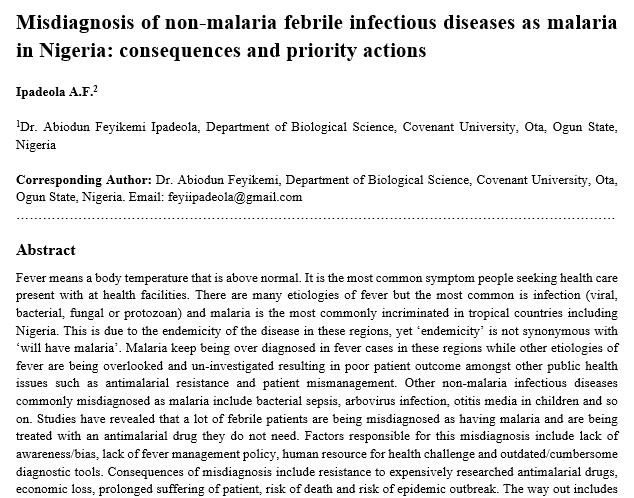Misdiagnosis of non-malaria febrile infectious diseases as malaria in Nigeria: consequences and priority actions
Abstract
Fever means a body temperature that is above normal. It is the most common symptom people seeking health care present with at health facilities. There are many etiologies of fever but the most common is infection (viral, bacterial, fungal or protozoan) and malaria is the most commonly incriminated in tropical countries including Nigeria. This is due to the endemicity of the disease in these regions, yet ‘endemicity’ is not synonymous with ‘will have malaria’. Malaria keep being over diagnosed in fever cases in these regions while other etiologies of fever are being overlooked and un-investigated resulting in poor patient outcome amongst other public health issues such as antimalarial resistance and patient mismanagement. Other non-malaria infectious diseases commonly misdiagnosed as malaria include bacterial sepsis, arbovirus infection, otitis media in children and so on. Studies have revealed that a lot of febrile patients are being misdiagnosed as having malaria and are being treated with an antimalarial drug they do not need. Factors responsible for this misdiagnosis include lack of awareness/bias, lack of fever management policy, human resource for health challenge and outdated/cumbersome diagnostic tools. Consequences of misdiagnosis include resistance to expensively researched antimalarial drugs, economic loss, prolonged suffering of patient, risk of death and risk of epidemic outbreak. The way out includes awareness that all fever cases are not malaria, implementation of fever management policy, research to establish other etiologies of fever in Nigeria other than malaria, testing for other etiologies of fever alongside malaria and use of better diagnostic tools for fever diagnosis.
Downloads
References
Petit, P.L., van Ginneken, J.K. Analysis of hospital records in four African countries, 1975–1990, with emphasis on infectious diseases. J Trop Med Hyg. 1995;98(4):217-227.
Feikin, D.R., Olack, B., Bigogo, G.M., Audi, A., Cosmas, L., Aura B, et al., The burden of common infectious syndromes at the clinic and household level from population-based surveillance in rural and urban Kenya. PLoS One.2011;6(1):e16085. doi: https://doi.org/10.1371/journal.pone.0016085.
Muller, T.C. and Partenkirchen, G. Non-malaria febrile illness- a cross sectional, observational study in rural areas of Cambodia. (2013). Available at http://www.pasteurkh.org/research/files/2013/02/Th%C3%A8se-Tara-Muller.pdf.
Ward, A. M. Patient Information: Fever in children (Beyond the Basics). (2015). Available at http://www.uptodate.com/contents/fever-in-children-beyond-the-basics.
Centers for Disease Control (CDC) National Notifiable Infectious Diseases. (2018) Available on https://wwwn.cdc.gov/nndss/conditions/notifiable/2018/infectious-diseases/.
Christian KA, Iuliano AD, Uyeki TM, Mintz ED, Nichol ST, Rollin P, et al. What We Are Watching—Top Global Infectious Disease Threats, 2013-2016: An Update from CDC's Global Disease Detection Operations Center. Health Secur. 2017;15(5):453-462. doi: http://doi.org/10.1089/hs.2017.0004.
Crump JA, Morrissey AB, Nicholson WL, Massung RF, Stoddard RA, Galloway RL et al. Etiology of Severe Non-malaria Febrile Illness in Northern Tanzania: A Prospective Cohort Study. PLoS Negl Trop Dis. 2013;7(7):e2324. doi: https://doi.org/10.1371/journal.pntd.0002324.
Pondei K, Olowu K, Peterside O. The aetiology of non-malarial febrile illness in children in the malaria-endemic Niger Delta Region of Nigeria. Asian Pac J Trop Dis. 2013;3(1):56-60. doi: https://dx.doi.org/10.1016%2FS2222-1808(13)60012-2.
Singh, S., Madaki, A.J., Jiya, N.M., Singh, R., Thacher, T.D. Predictors of malaria in febrile children in Sokoto, Nigeria. Niger Med J. 2014;55(6):480-485. doi: https://doi.org/10.4103/0300-1652.144701.
Baba M, Logue C.H., Oderinde B, Abdulmaleek H, Williams J, Lewis J. et al., Evidence of arbovirus co-infection in suspected febrile malaria and typhoid patients in Nigeria. J Infect Dev Ctries. 2013;7(1):51-59. doi: https://doi.org/10.3855/jidc.2411.
Peletiri, I.C Surmounting the seven major obstacles against the eradication of malaria in Nigeria: A review. Int J Malaria Res Rev. 2013;1(4):40-46.
Graber M. L. The incidence of diagnostic error in medicine. BMJ Quality and Safety. 2013;22(2):ii21-ii27. doi: https://doi.org/10.1136/bmjqs-2012-001615.
Leslie T, Mikhail A, Mayan I, Anwar M, Bakhtash S, Nader M, et al. Over diagnosis and mistreatment of malaria among febrile patients at primary healthcare level in Afghanistan: Observational study. BMJ. 2012;24:345:e4389. doi: https://doi.org/10.1136/bmj.e4389.
Isiguzo, C., Anyanti, J., Ujuju, C., Nwokolo, E.De La Cruz A., Schatzkin E., et al. Presumptive Treatment of Malaria from Formal and Informal Drug Vendors in Nigeria. PLOS One.2014;9(10):e110361. doi: https://doi.org/10.1371/journal.pone.0110361.
Kiekkas, P., Aretha, D., Bakalis, N., Karpouhtsi, I., Marneras C, Baltopoulos GI. Fever effects and treatment in critical care: literature review. Aust Crit Care. 2013;26(3):130-135. doi: https://doi.org/10.1016/j.aucc.2012.10.004.
Sullivan J.E, Farrar H.C., Fever and antipyretics use in children. Pediatr. 2011;127(3):580-587. doi: https://doi.org/10.1542/peds.2010-3852. Epub 2011 Feb 28.
Fenollar F, Mediannikov O. Emerging infectious diseases in Africa in the 21st century. New Microbe New Infect. 2018;26:S10-S18. doi: https://dx.doi.org/10.1016%2Fj.nmni.2018.09.004.
Fergus, T. Fever of Unknown Origin: A Clinical Approach. (2013). Available online at http://www.ubcmj.com/pdf/ubcmj_4_2_2013_14-16.pdf.
Keck School of Medicine Fever Approach Handbook. (2015). Available at www.keck.usc.edu/wp-content/uploads/sites/9/2015/02/KSOM-student-handbook-2014-151.pdf.
Oliveira AD, Prats C., Espasa M, Zarzuela Serrat F, Montañola SC, Silgado A, et al The Malaria System MicroApp: A New, Mobile Device-Based Tool for Malaria Diagnosis. JMIR Res Protocols. 2017;6(4):e70. doi: https://dx.doi.org/10.2196%2Fresprot.6758.
Pham NM, Karlen W, Beck HP, Delamarche E. Malaria and the ‘last’parasite: how can technology help? Malaria J. 2018;17(1):260. doi: https://doi.org/10.1186/s12936-018-2408-0.

Copyright (c) 2020 Author (s). Published by Siddharth Health Research and Social Welfare Society

This work is licensed under a Creative Commons Attribution 4.0 International License.


 OAI - Open Archives Initiative
OAI - Open Archives Initiative


